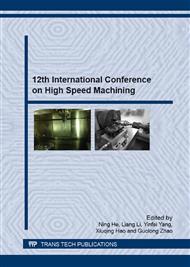[1]
S. l. Dai, K. Zhang, S.J. Yang, Advanced Areanautical Aluminum Alloy Materials Technology and Application, Beijing: National Defend Industry Press, (2012).
Google Scholar
[2]
G.L. Zhang, Study on the machinability of aero-aluminum alloy and distortion prediction and control of the aerospace beam, Shanghai: Shanghai Jiao Tong University, (2010).
Google Scholar
[3]
S. Antonio, G. Niccolò, FEM based cutting velocity selection for thin walled part machining, Procedia CIRP 14(2014)287 – 292.
DOI: 10.1016/j.procir.2014.03.023
Google Scholar
[4]
R.A. Izamshah, P.T. John, Finite element analysis of machining thin-wall parts. Key Engineering Materials. 458(2010)283-288.
DOI: 10.4028/www.scientific.net/kem.458.283
Google Scholar
[5]
S. Bolsunovskiy, V. Vermel, G. Gubanov, Thin-Walled Part Machining Process Parameters Optimization based on Finite-Element Modeling of Workpiece Vibrations, Procedia CIRP 8 (2013) 276 – 280.
DOI: 10.1016/j.procir.2013.06.102
Google Scholar
[6]
R. Seshadri, I. Naveen, S. Sharan, Finite Element Simulation of the Orthogonal Machining Process with Al 2024 T351 Aerospace Alloy, Procedia Engineering . 64 (2013) 1454 – 1463.
DOI: 10.1016/j.proeng.2013.09.227
Google Scholar
[7]
T.T. Chen, B. Rong, Y.F. Yang, FEM-based Prediction and Control of Milling Deformation for a Thin-wall Web of Ti-6Al-4V Alloy. Materials Science Forum Vols. 800-801 (2014) 368-373.
DOI: 10.4028/www.scientific.net/msf.800-801.368
Google Scholar
[8]
Y. Wang, X.F. WU, H.Z. Zhang, Finite Element Simulation of Deformation in Machining Large Thin-walled Aluminum Alloy Ring, Journal of Wuhan University of Technolotgy-Mater. S1(2009)95-99.
Google Scholar
[9]
G.Y. Wang, Y.X. Wu, P.F. Yan, Prediction model for machining deformation of aeronautical aluminum alloy thin-walled workpiece, Journal of Central South University (Science and Technology). 43(2012)1696-1702.
Google Scholar
[10]
G. Li, W.Y. Chen, P. Zhang, Analysis and Calculation on Machining Deformation of Parameterized Thin-Wall Workpiece Based on ANSYS, Aeronautical Manufacturing Technology . 19(2011)76-79.
Google Scholar


